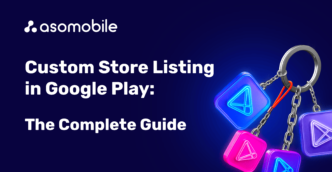How to measure the success of ASO optimization - key points and metrics
If you are a developer, an ASO specialist, or your business is related to the mobile games and applications market, you`ve met with the question - how to measure the success of ASO optimization. Then we have prepared the main metrics and key points for measuring the effectiveness of the ASO optimization process just for you.
You have placed your application on one of the app stores, what's next? And then you need ASO (App store optimization) which is a set of measures aimed at increasing the visibility of your application or game on the App Store or Google Play. It's like a gold shelf in traditional stores - a product that is at the eye level of consumers is sold out faster than a product that is higher or lower. Because the golden shelf is clearly visible.
Success, efficiency - all this is a measurement of the degree of goals achieved, which is why we will start with them.
At the end of the article, you can find a 40% discount coupon for the first month of using ASOMobile - a tool for creating ASO and researching competitors in the mobile app market.
The main goals of ASO optimization
ASO optimization is the process by which you can get your application on the golden shelf of stores by:
- Growth of positions in the ranking of the App Store or Google Play. The higher the position, the better. Here, as in Formula 1, everyone wants to get in first place. The closer to the first place, the greater the visibility of your application is. And in fact, the wider audience of end users will see your application.
- Growth in organic installs after viewing the app page. The process when a consumer independently finds and installs an application without first seeing any advertising information about this application is called organic installation or organic traffic.
The golden shelf here means the recommended applications that the store itself generates for a particular user, top charts, various selections by category (for example, games, health) and, of course, featuring - getting the application into the collections of stores, “Game of the Day”, “Editor's Choice ”, “App of the day” and others. Such collections are the first thing a user sees when he enters the App Store or Google Play, which means more views, downloads, and, ultimately, the user installs. Exactly what we need!
A great example is Popular Apps from the Google Play Market - how many users will see and possibly install apps from this collection? Difficult to calculate, but certainly not to be missed.

The App Store home screen example also serves as a great visualization of the breadth of possibilities:
How often should you do ASO?
So, we have learned what ASO optimization is and what its main goals are. How often should you do ASO? Is it enough to generate relevant keywords to search for an application at the start, evenly distribute them by title and description, and never return to this question? Or develop one icon and never touch it again?
The answer is not enough. Optimization is an ongoing process. Do you want to see your app in the top charts and organic search results? Then ASO is your conscious choice. Even the most unique and useful application must be constantly optimized, otherwise, the end-user will not see it and it will remain on the back of the stores.
There is a direct correlation here, the more often and more technically you use ASO, the better the effect of ASO optimization. A good ASO, like a perpetual mobile, should work without days off and holidays. Only a perpetual motion machine is a myth, and the constant use of ASO is a reality. And this reality, read optimization success, depends only on you and your desire to top the ratings and charts.
From all that, we can conclude that ASO is with you forever. And we turn to the question that concerns everyone - how to measure the success of application optimization?
So how do you measure the effectiveness of ASO? How to evaluate what has been done?
In general, the key ASO metrics are divided into:
- Internal, which are available only to the application developer. This is all statistics for the application - impressions, views, installs, in-app purchases, user retention rate, conversions. All that can be found in the console for the developer and evaluate the effectiveness of the efforts made.
- External, which are available to users, developers and third parties using mobile analytics tools. There are quantitative and qualitative external metrics of ASO optimization.
- Quantitative ones are all indicators that can be counted - indexed keywords, traffic, the position of the application in the search results for the keyword, and others.
- Qualitative metrics, relying on quantitative ones, are aimed at analysis in terms of the quality of the mentioned indicators.
Now let's move from general to specific and take a look at the key performance indicators (KPI) of the application in detail.
Key Performance Indicators (KPIs) for App Optimization
- Availability and visibility on app stores
The easier it is for a user to find your app on the App Store or Google Play, the higher the availability and visibility of the product are. For this “easier to find” various top charts and thematic collections, which are most often shown to customers of stores, are responsible. See more - install more. The number of installs is an important ASO KPI.
To assess the availability and visibility of your application in the stores, these indicators are responsible:
- The Keyword Rank tells you how the app ranks in the keyword search results. In simple words, if the app is shown in the top or in the first, but from the end)
- Place in the top charts. They are grouped by topics and parameters, for example, paid-free, “game of the day”, top picks. The presence of your app in such collections means success. The closer a product is to the top of the chart, the greater its availability and visibility.
- Category rating. The higher it is, the better your application is visible among similar ones, for example, among similar games or health apps.
- Featured is a list of recommended applications on the main page of the App Store or Google Play and the first thing a user sees when they enter these stores. Applications in this list are selected by store editors.
These metrics help you understand how easy it is to find an app on the App Store or Google Play and evaluate its availability and visibility.
- Conversion rates
The target action of a game or application is different for each of them - installing an application, in-app purchase, all kinds of subscriptions, registration, and other KPIs. Conversion is the most important performance indicator.
Equally, there are two indicators: the conversion rate and the conversion funnel. The conversion funnel demonstrates the sequence of user actions before taking the target action. The more targeted actions are carried out (read conversion), the better.
How to increase conversion using ASO processes?
The main vector of ASO optimization is aimed at:
- metadata
- icon and screenshots from the application
- audio and video content
By optimizing these parameters you increase:
- app visibility in search results.
- organic traffic
- ease of search or, in fact, its accessibility to the user.
- Ratings and reviews
Why are reviews and ratings also important?
In order for the App Store or Google Play to rank your application in the search results above others and for these stores to include it in their collections, you need to pay attention to its ratings and reviews.
App ratings and reviews are public and directly affect conversions. For example, Google Play searches have filters based on the rating “4.0 and above”. If the rating of your app is lower, then some part of the target audience will not see your product.
The rating consists of:
- monitoring reviews
- responses to reviews
- work with popular reviews
- work with negativity and spam.
- Organic growth
Organic traffic, as the main indicator of optimization effectiveness, is the traffic that comes to the application page from search results, recommendations, editorial selections, and top charts. App Store users even have a separate Trending Searches tab - top of the most popular queries.
In other words, an organic traffic flow is when a user finds and installs an application without any help or incentive from the developer. Organic always comes from search. Analyzing its share in the total traffic, we can talk about organic growth, and therefore about the effectiveness of ASO optimization.
Mistakes in measuring the effectiveness of text ASO
Let's take a look at the main mistakes when measuring the effectiveness of text ASO.
- Quality and quantity.
Above, we talked about quantitative and qualitative indicators of the effectiveness of the application. It is important to consider both quality and quantity. If you got +17 new words indexed for your application, then by quantitative standards, this is an increase. But, if the position of these +17 new words is not in the top 50 or at least the top 100, then from a qualitative point of view, there is no growth.
Be careful, always analyze this quality-quantity pair, do not separate them.
- Analysis of the dynamics of KPI indicators
From the first point, you learned that it is important to analyze qualitative and quantitative indicators in the context of each other. Now you will not be surprised to learn about the existence of another sweet couple, or rather a trio: Traffic - Conversion - Settings. Do not analyze the dynamics of changes in this section. If you miss anything from the chain, you will no longer be able to achieve your goals. If the application is indexed, installed, and then deleted by the user, something went wrong - analyze and fix it.
- External factors and ASO optimization
Evaluate ASO optimization without taking into account external factors. Let's dwell on this in more detail. First of all, looking for the reasons for low performance and other troubles is, of course, necessary in your ASO optimization strategy. But it is not always necessary to put all the blame only on ASO. Do not forget to look around, there is at least a market and its users around you.
Let it be, a fitness app. It was a regular fitness app, and during the times of global quarantine, following market trends and user behavior, the developer or his ASO specialist indexed the app for the keywords “fitness at home”. Excellent plan, correct argumentation, high performance, and at the peak of quarantine, even deafening. After a while, the quarantine came to an end. And the iteration of ASO-optimization was not carried out, although the previous one remains correct, but is no longer relevant. In the new post-quarantine world, where people are finally allowed to leave the house, an app indexed by “fitness at home” will not be relevant. But fast-moving competitors have already indexed their apps for “fitness in the park” or “fitness in nature” and are probably at least in the top 50. Because quarantine is over, no one needs fitness at home, all users went out to v.
Analyze not only the ASO strategy but also the market together with its users. Follow world news and trends, you and your app are part of it.
- Making complex changes.
Iterations of ASO optimization are, in fact, changes in the visual and text parameters of the app. But not just like a finger in the air, but based on the statistics of various KPIs. For example, you have changed the app icon (visual) and see an increase in the number of installs. So users like the icon, optimization is successful.
Now imagine that in one fell swoop you changed the icon, the name, and the description of the application. You have an increase in conversion per install. And what gave the increase in the number of installs? Icon? New name? Or a description? What specifically led to success? And it’s good if it’s for success, but what if the opposite?
Therefore, optimization should be phased, and preferably step by step. Hurry up slowly - do not change many parameters in one optimization.
How to measure the effectiveness of the text ASO based on ASOMobile analytics
Mobile analytics is designed for developers, analysts, ASO specialists, and everyone involved in mobile applications and games. That is why, when analyzing the effectiveness of ASO optimization, we encourage you to use the tools of analytical platforms.
An excellent example is the ASO Dashboard tool from ASOMobile, which in one click will allow you to evaluate how correctly and effectively the optimization of an application has been carried out. At your disposal are 10 infographics with dynamics, statistics, and data on the performance indicators of text ASO optimization:
- Search visibility is a measure of the success of ASO iterations. The higher the score, the more visible your application is in search results.
- Indexed keywords of your app with dynamics.
- Keyword changes in the context of New, Improved, Worsened, Dropped out of the TOP-50.

The keywords distribution is just an assessment of the effectiveness of both qualitative and quantitative. It is easy to visualize the indexed semantics and its quality - whether it is included in the TOP queries and how it is distributed.

Downloads by keywords will show the semantics that brings the most traffic to your application. Or, in this way, you can analyze competitors and use this information in the next changes in ASO.

As you can see, all the most necessary metrics and indicators are already collected in one place - one click, the whole picture is before your eyes. The conclusions are up to you.
And we have prepared the most common metrics by which you can evaluate the effectiveness of a mobile app promotion strategy. You can add new or extend existing ASO KPIs for your application.
- Availability and visibility on stores.
- Conversion rate.
- User activity to analyze their engagement.
- Revenue and customer lifetime value (LTV) is the profit that a user brings for the entire time they work with the application.
- User Acquisition Cost is all the money spent on attracting a user to an app.
- Number of downloads.
- Number of installs.
- Number of deletions.
- A churn rate that helps quantify users who have unsubscribed or uninstalled an app.
- The number of app users. Everything is logical here, the number of users should constantly grow.
- Application crashes. There shouldn't be any. Each failure leads to an outflow of users.
- If the application requires the use of gestures, for example, you need to move your finger across the screen, then the design of such an application must be of high quality. If some gestures do not work correctly, then the design should be optimized.
- Application loading time. The lower the time, the better. Nobody likes waiting.
- User retention rate, aka (retention). The user downloaded and installed the application, used it once and never returned to it - this is a low retention rate. Users should come back to you.
- The duration of each user session and their frequency. Tells us how long and how often the user uses the application.
- Daily/monthly number of active users.
- Devices on which applications are used. Collecting information about the devices on which the application is downloaded will help to optimize it more accurately.
- Custom permission. For example, on push notifications or using the camera. By giving their consent, the user increases their level of engagement.
- Reviews and comments on social networks. Not only their quantity is important, but also their quality. Positive feedback is nice and helpful, but negative feedback needs to be dealt with first. What do users write? Praise or scold? User comments are an endless source of optimization. Use this tool skillfully.
Proper use of the key performance indicators (KPIs) of the application presented in this article will lead your ASO optimization to success. Enjoy your optimization!
 Українська
Українська  Русский
Русский  Español
Español 






